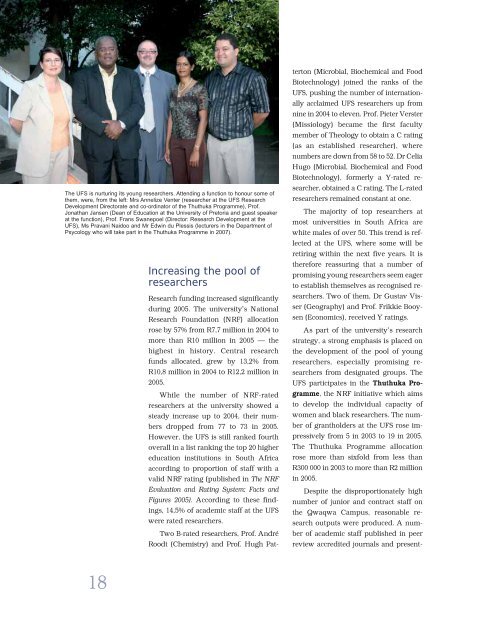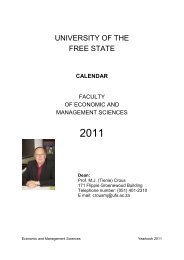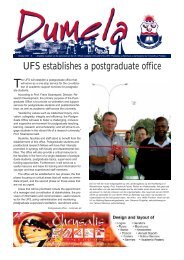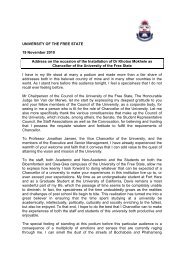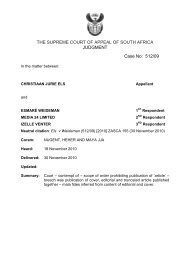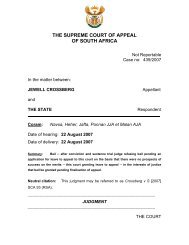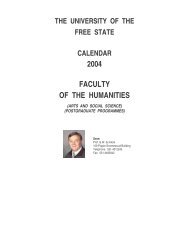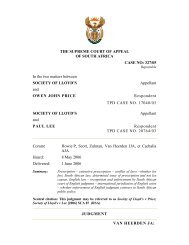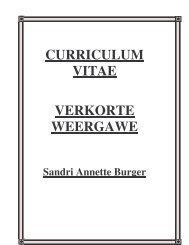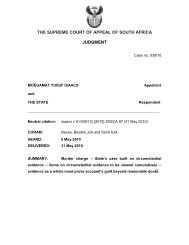Jaaroorsig - University of the Free State
Jaaroorsig - University of the Free State
Jaaroorsig - University of the Free State
You also want an ePaper? Increase the reach of your titles
YUMPU automatically turns print PDFs into web optimized ePapers that Google loves.
The UFS is nurturing its young researchers. Attending a function to honour some <strong>of</strong><strong>the</strong>m, were, from <strong>the</strong> left: Mrs Annelize Venter (researcher at <strong>the</strong> UFS ResearchDevelopment Directorate and co-ordinator <strong>of</strong> <strong>the</strong> Thuthuka Programme), Pr<strong>of</strong>.Jonathan Jansen (Dean <strong>of</strong> Education at <strong>the</strong> <strong>University</strong> <strong>of</strong> Pretoria and guest speakerat <strong>the</strong> function), Pr<strong>of</strong>. Frans Swanepoel (Director: Research Development at <strong>the</strong>UFS), Ms Pravani Naidoo and Mr Edwin du Plessis (lecturers in <strong>the</strong> Department <strong>of</strong>Psycology who will take part in <strong>the</strong> Thuthuka Programme in 2007).Increasing <strong>the</strong> pool <strong>of</strong>researchersResearch funding increased significantlyduring 2005. The university’s NationalResearch Foundation (NRF) allocationrose by 57% from R7,7 million in 2004 tomore than R10 million in 2005 — <strong>the</strong>highest in history. Central researchfunds allocated, grew by 13,2% fromR10,8 million in 2004 to R12,2 million in2005.While <strong>the</strong> number <strong>of</strong> NRF-ratedresearchers at <strong>the</strong> university showed asteady increase up to 2004, <strong>the</strong>ir numbersdropped from 77 to 73 in 2005.However, <strong>the</strong> UFS is still ranked fourthoverall in a list ranking <strong>the</strong> top 20 highereducation institutions in South Africaaccording to proportion <strong>of</strong> staff with avalid NRF rating (published in The NRFEvaluation and Rating System: Facts andFigures 2005). According to <strong>the</strong>se findings,14,5% <strong>of</strong> academic staff at <strong>the</strong> UFSwere rated researchers.Two B-rated researchers, Pr<strong>of</strong>. AndréRoodt (Chemistry) and Pr<strong>of</strong>. Hugh Pat-terton (Microbial, Biochemical and FoodBiotechnology) joined <strong>the</strong> ranks <strong>of</strong> <strong>the</strong>UFS, pushing <strong>the</strong> number <strong>of</strong> internationallyacclaimed UFS researchers up fromnine in 2004 to eleven. Pr<strong>of</strong>. Pieter Verster(Missiology) became <strong>the</strong> first facultymember <strong>of</strong> Theology to obtain a C rating(as an established researcher), wherenumbers are down from 58 to 52. Dr CeliaHugo (Microbial, Biochemical and FoodBiotechnology), formerly a Y-rated researcher,obtained a C rating. The L-ratedresearchers remained constant at one.The majority <strong>of</strong> top researchers atmost universities in South Africa arewhite males <strong>of</strong> over 50. This trend is reflectedat <strong>the</strong> UFS, where some will beretiring within <strong>the</strong> next five years. It is<strong>the</strong>refore reassuring that a number <strong>of</strong>promising young researchers seem eagerto establish <strong>the</strong>mselves as recognised researchers.Two <strong>of</strong> <strong>the</strong>m, Dr Gustav Visser(Geography) and Pr<strong>of</strong>. Frikkie Booysen(Economics), received Y ratings.As part <strong>of</strong> <strong>the</strong> university’s researchstrategy, a strong emphasis is placed on<strong>the</strong> development <strong>of</strong> <strong>the</strong> pool <strong>of</strong> youngresearchers, especially promising researchersfrom designated groups. TheUFS participates in <strong>the</strong> Thuthuka Programme,<strong>the</strong> NRF initiative which aimsto develop <strong>the</strong> individual capacity <strong>of</strong>women and black researchers. The number<strong>of</strong> grantholders at <strong>the</strong> UFS rose impressivelyfrom 5 in 2003 to 19 in 2005.The Thuthuka Programme allocationrose more than sixfold from less thanR300 000 in 2003 to more than R2 millionin 2005.Despite <strong>the</strong> disproportionately highnumber <strong>of</strong> junior and contract staff on<strong>the</strong> Qwaqwa Campus, reasonable researchoutputs were produced. A number<strong>of</strong> academic staff published in peerreview accredited journals and present-18


